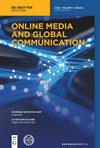Examining visual impact: predicting popularity and assessing social media visual strategies for NGOs
引用次数: 0
Abstract
Abstract Purpose This research aims to analyze the role of visuals posted on the social media of NGOs and to predict the popularity of a post based on the characteristics of the visual it contains. Design/methodology/approach Two social media platforms, namely Facebook and Instagram, were selected as the empirical study environments. Specifically, all visuals posted on 12 child-related Non-Government Organizations during the period of 2020–2021 (4,144 in total) were collected and subsequently subjected to automatic characterization using visual recognition and artificial intelligence tools. Machine learning algorithms were then employed to predict the popularity of a post solely based on the visuals it contains, as well as to identify the most significant features that serve as predictors for post popularity. Findings The Support Vector Classifier performed best with a prediction accuracy of 0.62 on Facebook and 0.81 on Instagram. For the explanation of the model, we used feature importance metrics and found that features like the presence of people and the emotions of joy and calmness are important for the prediction. Practical implications Companies and organizations serve a large part of their communication strategy through social media. Given that every advertiser would like to use their funds in the most efficient way, the ability to predict the performance of a post would be a very important tool. Social implications The methodology can be used in the non-profit sector, whereby knowing what visual will perform better they could promote their mission more effectively, increase public awareness, raise funds and reduce expenses on their communication strategy. Originality/value The novelty of this work regarding popularity prediction on social media lies in the fact that to make the prediction, it focused exclusively on the visual and its characteristics and achieved high accuracy scores in the case of Instagram. Additionally, it provided important information about visual characteristics and their importance in predicting popularity.检验视觉影响:预测受欢迎程度并评估非政府组织的社交媒体视觉策略
摘要目的本研究旨在分析ngo社交媒体上发布的视觉效果的作用,并根据其所包含的视觉效果特征来预测帖子的受欢迎程度。设计/方法/方法选择两个社交媒体平台,即Facebook和Instagram作为实证研究环境。具体而言,收集了2020-2021年期间12个与儿童有关的非政府组织(共4144个)发布的所有视觉效果,随后使用视觉识别和人工智能工具进行自动表征。然后使用机器学习算法仅根据其包含的视觉效果来预测帖子的受欢迎程度,并确定作为帖子受欢迎程度预测因子的最重要特征。支持向量分类器在Facebook和Instagram上的预测准确率分别为0.62和0.81。对于模型的解释,我们使用了特征重要性指标,发现像人的存在以及喜悦和平静的情绪这样的特征对预测很重要。公司和组织的很大一部分沟通策略是通过社交媒体实现的。考虑到每个广告主都希望以最有效的方式使用他们的资金,预测广告效果的能力将是一个非常重要的工具。该方法可用于非营利部门,由此知道什么视觉将更好地执行,他们可以更有效地促进他们的使命,提高公众意识,筹集资金,并减少他们的沟通策略的开支。这项关于社交媒体人气预测的工作的新颖之处在于,它只关注视觉及其特征,并在Instagram的情况下取得了很高的准确率分数。此外,它还提供了关于视觉特征及其在预测受欢迎程度方面的重要性的重要信息。
本文章由计算机程序翻译,如有差异,请以英文原文为准。
求助全文
约1分钟内获得全文
求助全文
来源期刊

Online Media and Global Communication
Communication, Media Studies, Internet Studies, International Studies, International Relations-
自引率
0.00%
发文量
0
期刊介绍:
Online Media and Global Communication (OMGC) is a new venue for high quality articles on theories and methods about the role of online media in global communication. This journal is sponsored by the Center for Global Public Opinion Research of China and School of Journalism and Communication, Shanghai International Studies University, China. It is published solely online in English. The journal aims to serve as an academic bridge in the research of online media and global communication between the dominating English-speaking world and the non-English speaking world that has remained mostly invisible due to language barriers. Through its structured abstracts for all research articles and uniform keyword system in the United Nations’ official six languages plus Japanese and German (Arabic, Chinese, English, French, Russian, Spanish, Japanese, and German), the journal provides a highly accessible platform to users worldwide. Its unique dual track single-blind and double-blind review system facilitates manuscript reviews with different levels of author identities. OMGC publishes review essays on the state-of-the-art in online media and global communication research in different countries and regions, original research papers on topics related online media and global communication and translated articles from non-English speaking Global South. It strives to be a leading platform for scientific exchange in online media and global communication.
For events and more, consider following us on Twitter at https://twitter.com/OMGCJOURNAL.
Topics
OMGC publishes high quality, innovative and original research on global communication especially in the use of global online media platforms such as Facebook, TikTok, YouTube, Twitter, Instagram, WhatsApp, Weibo, WeChat, Wikipedia, web sites, blogs, etc. This journal will address the contemporary concerns about the effects and operations of global digital media platforms on international relations, international public opinion, fake news and propaganda dissemination, diaspora communication, consumer behavior as well as the balance of voices in the world. Comparative research across countries are particularly welcome. Empirical research is preferred over conceptual papers.
Article Formats
In addition to the standard research article format, the Journal includes the following formats:
● One translation paper selected from Non-English Journals that with high quality as “Gems from the Global South” per issue
● One review essay on current state of research in online media and global communication in a country or region
 求助内容:
求助内容: 应助结果提醒方式:
应助结果提醒方式:


